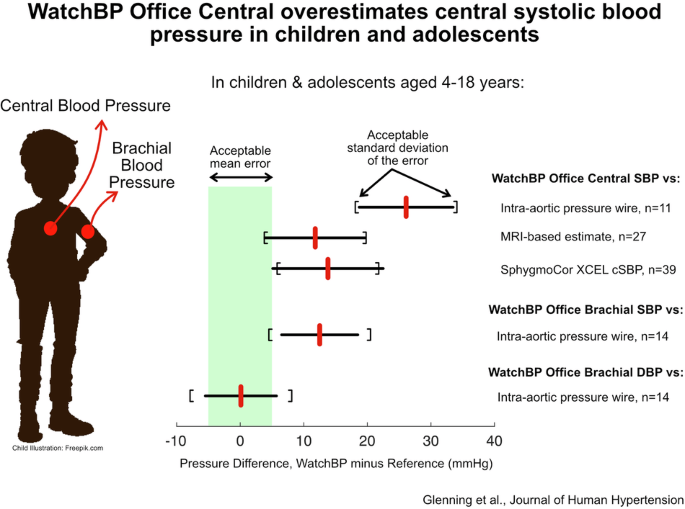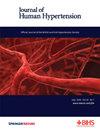Accuracy of the WatchBP Office Central as a Type 2 device for non-invasive estimation of central aortic blood pressure in children and adolescents
IF 3.4
4区 医学
Q2 PERIPHERAL VASCULAR DISEASE
引用次数: 0
Abstract
High blood pressure (BP) in childhood is a recognised precursor of elevated cardiovascular risk in adulthood. Brachial BP is normally used for clinical decision making, but central BP may be a better marker of pressure load on the heart. There is a paucity of validated non-invasive, automated devices for estimating central BP in children and adolescents. In this study, we compared the WatchBP Office Central (a Type 2 central pressure estimation device) against a high-fidelity micromanometer in the ascending aorta of anaesthetised patients undergoing clinically-indicated catheterisation (n = 15, age 4–16 years). As a secondary aim, central systolic BP (cSBP) was also compared to two non-invasive estimation methods in 34 awake patients undergoing routine cardiac MRI (age 10–18 years). WatchBP substantially overestimated cSBP compared to the intra-arterial gold-standard reference (26.1 ± 7.4 mmHg), and recruitment was terminated at n = 11 (included in the analysis) due to high statistical certainty that the device would not pass the validation criteria of 5±8 mmHg. WatchBP cSBP was also substantially higher than values obtained from a phase contrast MRI method (11.8 ± 7.9 mmHg) and the SphygmoCor XCEL (13.5 ± 8.9 mmHg) in the awake patient group, which translate to 21–23 mmHg on average after accounting for known/estimated biases in these non-invasive comparators. Compared with invasive central diastolic and systolic BPs, the brachial measures from WatchBP yielded errors of 0.1 ± 5.6 and 12.5 ± 6.0 mmHg respectively. We conclude that the WatchBP substantially overestimates cSBP in children and adolescents. These findings reinforce the need for central BP-measuring devices to be further developed and validated in this population.


WatchBP Office Central 作为 2 类设备,对儿童和青少年中心主动脉血压进行无创估测的准确性
儿童时期的高血压是成年后心血管风险升高的公认前兆。肱动脉血压通常用于临床决策,但中心血压可能是心脏压力负荷的更好标记。目前还缺乏经过验证的无创自动设备来估测儿童和青少年的中心血压。在这项研究中,我们比较了 WatchBP Office Central(一种 2 型中心血压估测设备)和高保真微压计在接受临床指定导管插入术的麻醉患者(n = 15,年龄 4-16 岁)的升主动脉中的测量结果。作为次要目的,还对 34 名接受常规心脏核磁共振成像检查的清醒患者(年龄 10-18 岁)的中心收缩压(cSBP)与两种无创估测方法进行了比较。与动脉内黄金标准参考值(26.1 ± 7.4 mmHg)相比,WatchBP 大大高估了 cSBP,由于统计学上高度确定该设备无法通过 5±8 mmHg 的验证标准,因此在 n = 11(包括在分析中)时终止了招募。在清醒患者组中,WatchBP cSBP 也大大高于通过相位对比 MRI 方法(11.8 ± 7.9 mmHg)和 SphygmoCor XCEL(13.5 ± 8.9 mmHg)获得的数值,在考虑了这些无创比较器的已知/估计偏差后,平均值为 21-23 mmHg。与有创中心舒张压和收缩压相比,WatchBP 的肱动脉测量误差分别为 0.1 ± 5.6 mmHg 和 12.5 ± 6.0 mmHg。我们的结论是,WatchBP 大大高估了儿童和青少年的 cSBP。这些研究结果进一步说明,有必要在这一人群中进一步开发和验证中心血压测量设备。
本文章由计算机程序翻译,如有差异,请以英文原文为准。
求助全文
约1分钟内获得全文
求助全文
来源期刊

Journal of Human Hypertension
医学-外周血管病
CiteScore
5.20
自引率
3.70%
发文量
126
审稿时长
6-12 weeks
期刊介绍:
Journal of Human Hypertension is published monthly and is of interest to health care professionals who deal with hypertension (specialists, internists, primary care physicians) and public health workers. We believe that our patients benefit from robust scientific data that are based on well conducted clinical trials. We also believe that basic sciences are the foundations on which we build our knowledge of clinical conditions and their management. Towards this end, although we are primarily a clinical based journal, we also welcome suitable basic sciences studies that promote our understanding of human hypertension.
The journal aims to perform the dual role of increasing knowledge in the field of high blood pressure as well as improving the standard of care of patients. The editors will consider for publication all suitable papers dealing directly or indirectly with clinical aspects of hypertension, including but not limited to epidemiology, pathophysiology, therapeutics and basic sciences involving human subjects or tissues. We also consider papers from all specialties such as ophthalmology, cardiology, nephrology, obstetrics and stroke medicine that deal with the various aspects of hypertension and its complications.
 求助内容:
求助内容: 应助结果提醒方式:
应助结果提醒方式:


